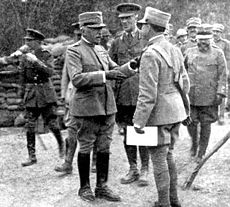Luigi Cadorna - Picture
More about World War 1

|
|
Luigi Cadorna
Place of birth: Verbania, Italy
Place of death: Bordighera, Italy
Allegiance: Kingdom of Italy
Service/branch: Royal Italian Army
Rank: Marshal of Italy
Battles/wars: World War I

Picture - General Cadorna visiting British batteries during World War I.
Luigi Cadorna GCB (September 4, 1850, Verbania, Piedmont - December 21, 1928) was an Italian Field Marshal, most famous for being the chief of staff of the Italian army during the first part of World War I.
Biography
Luigi Cadorna was born to General Raffaele Cadorna in Verbania Pallanza, Piedmont in 1850, and he joined the Italian Army in 1868. He was offered the post of chief of staff for the first time in 1908, which he rejected due to the issue of political control during wartime. He was again offered the position in July 1914, as the Triple Entente and Central Powers girded for war. When Italy entered the war in May 1915 on the side of the Entente, Cadorna fielded thirty-six infantry divisions composed of 875,000 men, but only 120 modern artillery pieces.
First World War
Cadorna launched four offensives in 1915, all along the Isonzo River. The goal of these offensives was the fortress of Gorizia, the capture of which would permit the Italian armies to pivot south and march on Trieste, or continue on to the Ljubljana Pass. All four offensives failed, resulting in some 250,000 Italian casualties for little material gain. Cadorna would ultimately fight eleven battles on the Isonzo between 1915 and 1917. Additional forces were arrayed along the Trentino salient, attacking towards Rovereto, Trento, and Bolzano. These attacks also failed. The terrain along the Isonzo and Trentino was completely unsuited for offensive warfare-mountainous and broken, with no room for maneuver.
Historians describe Cadorna as a martinet, excessively ruthless with his troops and dismissive of his country's political authorities. During the course of war he fired 217 officers; during the Battle of Caporetto he would order the summary execution of officers whose units retreated. His harsh approach to discipline has been described as follows by one historian:
One in every seventeen Italian soldiers faced a disciplinary charge in the war, and 61 per cent were found guilty. About 750 were executed, the highest number of any army in the war, and Cadorna reintroduced the Roman practice of decimation - the killing of every tenth man - for units which failed to perform in battle.
One in every seventeen Italian soldiers faced a disciplinary charge in the war, and 61 per cent were found guilty. About 750 were executed, the highest number of any army in the war, and Cadorna reintroduced the Roman practice of decimation - the killing of every tenth man - for units which failed to perform in battle.
On October 24, 1917, a combined Austro-Hungarian/German army struck across the Isonzo River at Caporetto and by November 12 had advanced all the way to the Piave River. Cadorna's disposition of most of his troops far forward, with little defense in depth, contributed greatly to the disaster; but graver still were the responsibilities of other officers, notably Pietro Badoglio, then corps commander in a sector overrun by the Austro-German attack. The Italian Army fled in disarray and seemed on the verge of total collapse; 275,000 soldiers surrendered. Cadorna was sacked and replaced by General Armando Diaz; he was appointed as the Italian representant to the Allied Supreme War Council set up in Versailles. Then the Italian forces rallied behind the Piave and Monte Grappa (a mountain Cadorna himself had previously begun to fortify, in a moment of almost prophetical insight) and reversed, with the help of several Allied divisions, the course of the conflict.
After the war, there was an enquiry held by the Italian government to investigate the defeat at Caporetto. It was published in 1919 and was highly critical of Cadorna, at that time a bitter man busy in writing his memoirs who claimed that he had no responsibility for the defeat, despite fleeing to Padua during the battle and abandoning the entire Italian Second Army to its fate. Nevertheless, he was made a Field Marshal (Maresciallo d'Italia) in 1924 when Benito Mussolini seized power.
Great Britain appointed Cadorna an honorary Knight Grand Cross of the Order of the Bath (GCB) in 1915.
Field Marshal Cadorna died in Bordighera in 1928.
He was the father of Raffaele Cadorna, Jr, an Italian general who fought during World War I and World War II, who was famous as one of the commanders of the Italian Resistance against German occupying forces in north Italy after 1943.
Keegan, John (1999). The First World War. New York: Alfred A. Knopf. ISBN 0-375-40052-4.
Marshall, S. L. A.. The American Heritage History of World War I. New York: American Heritage.
More aircraft.
Source: WikiPedia